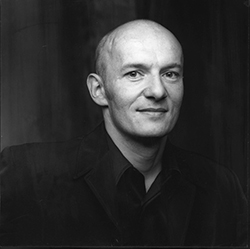In his thesis MA (Dipl. Des.) Markus Schröppel focuses on producing guidance aid for large, shared spaces through graphic design. The results of the study and the corresponding solutions and recommendations can be used to avoid problems in confronting icons and guidance systems. The presented solutions, with the array of methodologies and the focus on the user, enable us to efficiently check and evaluate the functionality of existing sign systems.
Only a moment's disorientation can bring joy or cause an utter disaster,
or lead to the loss of an entire annual holiday, or ruin the success of
a business transaction. Such tragedies and changes of fortune happen
every day at international airport terminals when passengers desperately
search for the departure gate. The rapid development of international
traffic characterises our increasingly globalised and ever more complex
world. Long-haul travel is booming as a result of reduced fares, and
airport terminals are suddenly populated by hordes of people unfamiliar
with the local "access interface". Airports have formed in nodal points,
where people from various cultural backgrounds and with differing
levels of education need to reorient themselves in an unfamiliar and
often confusing environment.
According to Mr. Markus Schröppel, a
key condition for ensuring that everything works smoothly in such an
international junction is the fast reception and immediate processing of
information by everyone involved. Numerous studies attest the
difficulty experienced by airline passengers in trying to navigate their
way through an unfamiliar and crowded environment with the help of a
symbol- and text-based signage system.
Designers usually do not
focus on the use pictograms. On the basis of a number of case studies,
the following question has arisen: "Is it possible to evolve a
predictive system to develop, implement, and verify design solutions to
direct and optimise the flow of visitors in large public spaces?"
Overcoming age, language and culture barriers
In
his dissertation Mr. Markus Schröppel focused on the visual perception
and spatial orientation of people seeking their way through large and
crowded spaces. The moment of meaning-making is experienced differently
by each individual and spans the entire spectrum of perceiving a
designated item – from manifold interpretations to absolute certainty.
The various perspectives on "situational awareness", accompanied by a
number of methodologies, provide solutions to the design process.
Furthermore, taking into account perceptual psychology contributes to
the systemic/holistic and user-centred design of orientation systems in
public spaces.
Identifying and consulting the predictive
parameters of a systematic process yields practicable solutions to the
planning and evaluation of guidance and routing systems. The process
reliability and processing quality of these solutions have been
demonstrated in various national and international case studies. Through
observation and interpretation, the ethnic habits and personal views of
people were taken into account to develop the method. The capacity of
the model and the perationalisation of the research demonstrated the
effectiveness of the method in overcoming the barriers of age, language,
and culture.
A variety of experiments and practical applications
show that this thesis is not merely based on logical conclusions. Here
are a few examples of applications already implemented through the
method: the rework of the Public Guidance System at the Düsseldorf
Airport (2007); Reflection on the Experience of Signage Without Signs:
Krefeld (GER) Hospital (2008); Testing and Optimisation the Visual
Saliency of Signs at the Bremen (GER) Airport (2009); Raising Public
Awareness for the Design of Public Spaces and Signage in the Berlin
(GER) Humboldthain Park (2010); and Development of a User-Friendly
Design for a Signage System for Adults and Children at the Junior Uni,
Wuppertal (GER) (2013).
Information on the public examination of the dissertation:
MA
(Dipl. Des.) Markus Schröppel's doctoral thesis
Elimination of doubt:
Methods for a predictive design to direct and optimise the flow of
visitors will be publicly examined at the Faculty of Art and Design,
University of Lapland on Saturday 28 November 2015 at 12 noon in the
Esko ja Asko auditorium (street address: Yliopistonkatu 8, Rovaniemi).
The Opponent will be Dr., Senior Lecturer Joyce S. R. Yee from the
Northumbria University, Newcastle Upon Tyne (UK). The Custos will be
Professor Dr. Riitta Brusila from the University of Lapland. Welcome!
Information on the doctoral candidate:

Mr.
Markus Schröppel (born 1965 in Nördlingen, Bavaria, Germany) graduated
as a diploma designer in 1996 at Fachhochschule Augsburg, Germany and
received a second diploma in 2002 at Wuppertal University, Germany. Mr.
Schröppel studied as an exchange student in 1994–1995 at Rovaniemen
taide- ja käsiteollisuusoppilaitos, Finland.
In addition to his
positions as a creative director in advertising agencies, he has been a
teacher and trainer of communications design and typography since 1996
and given lectures on visual communication at the University of Lapland
since 2007.
He is currently working as a professor of graphic
design and visual communication at the HMKW (Hochschule für Medien,
Kommunikation und Wirtschaft) University of Applied Sciences, Germany.
Further information:
Markus Schröppel
m.schroeppel (at) hmkw.de
Tel. +49 221 22 21 39 27
www.mschroeppel.de
Press copies of the thesis are available at Lapland University Press, tel. 040 821 4242, publications (at) ulapland.fi.
Printed
copies of the book can be purchased via
Verkkokauppa Juvenes.
Information on the Publication:
Markus
Schröppel:
Elimination of doubt: Methods for a predictive design to
direct and optimise the flow of visitors. Acta Universitatis
Lapponiensis 313. ISBN 978-952-484-857-2. ISSN 0788-7604. Web version
(pdf): Acta Electronica Universitatis Lapponiensis 181. ISBN
978-952-484-858-9. ISSN (pdf) 1796-6310.
ULapland / Communications & Language Centre / RJ&AT